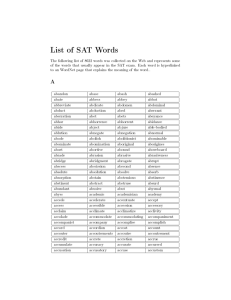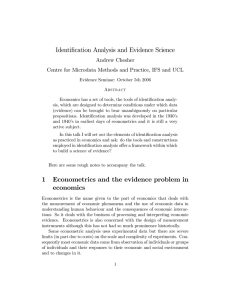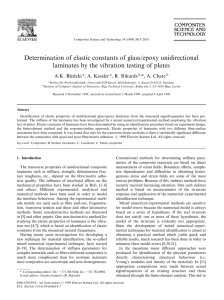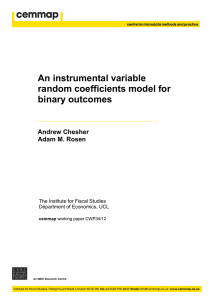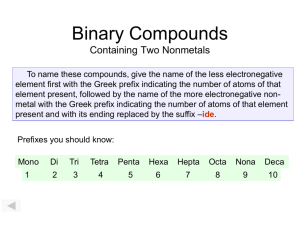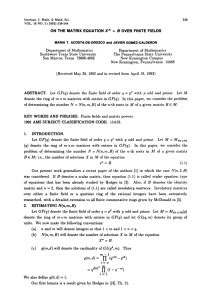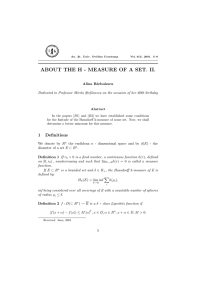Document 11243564
advertisement
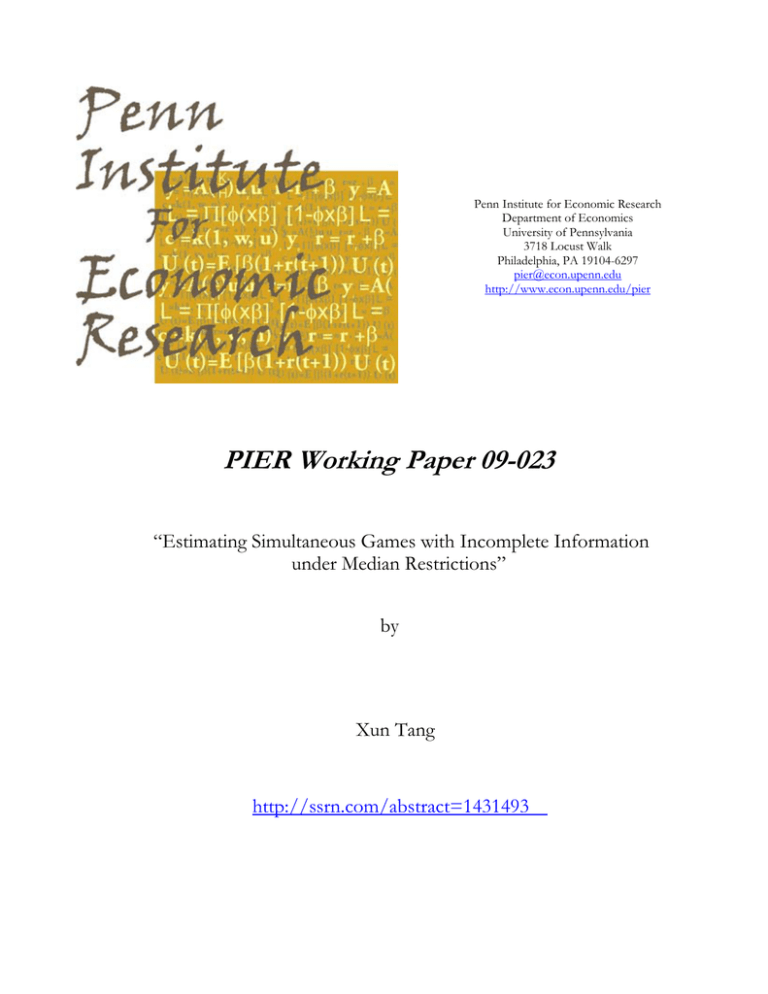
Penn Institute for Economic Research
Department of Economics
University of Pennsylvania
3718 Locust Walk
Philadelphia, PA 19104-6297
pier@econ.upenn.edu
http://www.econ.upenn.edu/pier
PIER Working Paper 09-023
“Estimating Simultaneous Games with Incomplete Information
under Median Restrictions”
by
Xun Tang
http://ssrn.com/abstract=1431493
Estimating Simultaneous Games with Incomplete Information
under Median Restrictions
Xun TANG1
University of Pennsylvania
April 30, 2009
Abstract
I estimate a simultaneous discrete game with incomplete information where players’private information are only required to be median independent of observed states and can be
correlated with observable states. This median restriction is weaker than other assumptions
on players’private information in the literature (e.g. perfect knowledge of its distribution
or its independence of the observable states). I show index coe¢ cients in players’ utility
functions are point-identi…ed under an exclusion restriction and fairly weak conditions on
the support of states. This identi…cation strategy is fundamentally di¤erent from that in
a single-agent binary response models with median restrictions, and does not involve any
parametric assumption on equilibrium selection in the presence of multiple Bayesian Nash
equilibria. I then propose a two-step extreme estimator for the linear coe¢ cients, and prove
its consistency.
KEYWORDS: Games with incomplete information, semiparametric identi…cation, median restrictions, consistent estimation
JEL CODES: C14, C35, C51
1
Corresponding author: Xun Tang, University of Pennsylvania, 3718 Locust Walk, Philadelphia, PA
19104. Tel: 215-898-7409. Email: xuntang@econ.upenn.edu. Fax: 215-573-2057.
This paper evolves from a chapter of my Ph.D. dissertation at Northwestern University. I am grateful
to Elie Tamer for detailed discussions and comments. I also thank Andrés Aradillas-López, Hanming Fang,
Stefan Hoderlein, Bo Honoré, Joel Horowitz, Shakeeb Khan, Charles Manski, Rosa Matzkin, Ulrich Müller,
Aureo De Paula, Robert Porter, Kyungchul Song, Petra Todd and the econometrics seminar participants at
Northwestern, Princeton, and University of Pennsylvania for helpful feedbacks. Financial support from the
Center of Studies in Industrial Organizations at Northwestern University is gratefully acknowledged.
2
1
Introduction
Consider a simple 2-by-2 simultaneous discrete game with incomplete information where the
space of pure strategies f1; 0g is the same for both players i = 1; 2. The payo¤ structure is :
0
1
0
0,0
X0
1
1; 0
1
0; X0
X0 1 + 1
2
2
0
1; X
2
+
2
2
where X 2 RK are states observed by players and econometricians, and i 2 R1 is private
information (PI) observed by player i only but not the rival or econometricians.2 The rows
and the columns correspond to the strategies of players 1 and 2 respectively. The …rst
expressions in each of the four cells correspond to the payo¤s for player 1, while the second
expressions correspond to those for player 2. The joint distribution of PI given X (denoted
by F jX where
( 1 ; 2 )) and parameters
f i ; i gi=1;2 are common knowledge among
players. Let R denote the support of a generic random variable R. A pure strategy for
player i is a mapping gi : X
! f0; 1g.3 A pure-strategy Bayesian Nash equilibrium
i
(BNE) is summarized by a pair of mappings Ai : X ! i that maps from a x 2 X to
a subset of i (so that the pure strategies are gi (x; "i ) = 1("i 2 Ai (x)) where 1(:) is the
indicator function) and
A1 (x) = f"1 : "1
x0
1
+
1P ( 2
2 A2 (x)j"1 ; x)g
A2 (x) = f"2 : "2
x
0
2
+
2P ( 1
2 A1 (x)j"2 ; x)g
Obviously Ai (x) depends on f i ; i gi=1;2 and F jX=x , and is independent of realized values
of ("1 ; "2 ).4 The existence of BNE follows from an application of Brouwer’s Fixed Point
Theorem but uniqueness is not guaranteed. Econometricians only know i < 0 for i = 1; 2,
and the following restrictions are satis…ed by the data-generating process (DGP).
CMI (Conditional and median independence) 1 is independent of
with M ed( i jX = x) = 0 for i = 1; 2 almost everywhere on X .
2
conditional on X
SE (Single equilibrium) If multiple BNE exist, only a single equilibrium is played in the
DGP.
2
I use upper case letters to denote random variables or vectors (such as ), and lower case letters for
their realizations (such as ").
3
Our approach allows for the dependence of support of on states X. We use
to denote the support
of private information only for the sake of simplicity in exposition.
4
More generally, pure-strategies should take the form gi (x; "i ) = 1("i 2 Ai ("i ; x)), but this can be easily
represented as gi (x; "i ) = 1("i 2 Ai (x)) with Ai (x) f"i : "i 2 Ai ("i ; x)g.
3
Under CMI and SE, the observed choice probabilities p(x) [p1 (x) p2 (x)] in the DGP
(where pi (x) denotes the probability that i chooses 1 under state x) must solve,
p1 (x)
F 1 jX=x (x0
=
p2 (x)
F 2 jX=x (x0
+ p2 (x) 1 )
2 + p1 (x) 2 )
1
(1)
We shall argue below that under CMI and SE, a pair ( ; F 1 ; 2 jX ) generates p(x) if and only if
it generates pi (x) in two simultaneous "binary response" models Yi = 1(X 0 i +p i (X) i i
0) for i = 1; 2. The interaction term i needs to be normalized to 1 for i = 1; 2 to identify
i under median restrictions alone.
This paper de…nes and characterizes the identi…cation region of i , gives su¢ cient conditions for point identi…cation of f i gi=1;2 and proposes a semiparametric two-step extreme
estimator that is consistent for the identi…ed set (under the Hausdor¤ metric). The identi…cation strategy in this game theoretic context is fundamentally di¤erent from arguments used
in a single-agent, binary response model with median restrictions (such as Manski (1985),
Manski and Tamer (2002)). This is because in a Bayesian Nash equilibrium, opponents’
choice probabilities enter players’ payo¤s as an additional state variable, thus invalidating
the large support assumption on regressors that has been used in the identi…cation in singleagent binary response models under median independence. Our solutions is to exploit an
exclusion restriction in linear index utilities and introduce a fairly weak condition that only
requires regressors’support to be closed under scalar contractions (i.e. multiplications with
some constant j j < 1). Then point-identi…cation can be achieved with bounded support of
regressors.
Several recent works have estimated simultaneous discrete games with incomplete information under di¤erent assumptions. Aradillas-Lopez (2005) studied a case where ( 1 ; 2 ) are
jointly independent from observable states X. He extended the semiparametric likelihood
estimator in Klein and Spady (1993) to this game-theoretic framework. He gave su¢ cient
and necessary conditions for the uniqueness of BNE, which is necessary for a well-de…ned
likelihood. Bajari, Hong, Krainer and Nekipelov (2007) showed a general function u(X) can
be identi…ed nonparametrically provided private information (PI) are independently and
identically distributed across players given X and that F"1 ;"2 jX is perfectly known to the
econometrician. In comparison, I formulate the BNE as a system of two binary regressions
(where rivals’equilibrium choice probabilities enter as an additional regressor) under much
weaker restrictions of median independence. Point identi…cation of index coe¢ cients is attained under the weak median restriction at a moderate cost of some additional (yet fairly
general) conditions on the support of regressors.
4
2
2.1
Identi…cation of Index Coe¢ cients
Partial identi…cation
Let FCM I denote the set of distributions of private information F jX that satisfy CM I. Let
( 0 ; F 0jX ) denote the true index coe¢ cients and the distribution of private information (PI)
in the DGP, and let p
(p1 ; p2 ) where pi (x; 0 ; F 0jX ) is the probability that " i chooses 1
in state x" actually observed in the DGP with true parameters ( 0 ; F 0jX ). For any generic
pair of coe¢ cients
f i ; i gi=1;2 and PI distribution G jX , let (x; ; G jX ) denote the set
of choice probabilities under state x implied by a model with ; G jX . That is,
(x; ; G jX )
f(p1 ; p2 ) 2 [0; 1]2 : (p1 ; p2 ) solves (1) given x; ; G jX=x g
(2)
The mapping is non-empty by the Brouwer’s …xed point theorem but might be a correspondence in general as uniqueness is not guaranteed. De…ne
(p ; b; G"jX )
Let
fx : (p1 (x); p2 (x)) 2 (x; b; G jX )g
(3)
denote the parameter space for .
De…nition 1 Given a p observed in the DGP with
o:e:
0
2
and F 0jX 2 FCM I , a parameter
is observationally equivalent (denoted ~ ) to 0 under FCM I if 9F jX 2 FCM I such that
PrfX 2 (p ; ; F jX )g = 1. The identi…cation region of 0 under FCM I is the subset of
o:e:
such that ~ 0 under FCM I for all in the subset. We say
if this identi…cation region is the singleton 0 .
0
is point-identi…ed under FCM I
Two remarks are necessary. First, identi…cation is relative to the BNE outcome p actuo:e:
ally observed in the DGP (which, under SE, solves (1)). Second, the de…nition of " ~ " only
requires marginal choice probabilities of the players to be rationalizable by the implied BNE
under ( ; F jX ), even though econometricians get to observe their joint choice probabilities.
This is because under the CMI and SE, the joint choice probability equals a product of two
marginal probabilities, and our point of departure is the choice probabilities observed in
DGP satisfy this testable implication so that the identi…cation region will not be vacuously
empty.
Let i ( i ; i ) and i denote the corresponding parameter space. Suppose the model
i
is correctly speci…ed for some 0 ; F 01 ; 2 jX 2
FCM I . Let FM
I denote the set of marginal
5
distributions of i that correspond to a joint distribution F jX in FCM I . For any x 2 X and
a pair of generic parameters 2 , G jX 2 FCM I , de…ne the analogs to (2) and (3) in the
context of single-agent decisions:
G i jx (x0
i (x; i ; G i jX ; p i )
i
+ p i (x) i )
and
i (p
; i ; G i jX )
fx : pi (x) =
i (x; i ; G i jX ; p i )
De…nition 2 Given an BNE outcome p observed in a DGP with ( 0 ; F 0jX ),
i
is unilaterally
u:o:e:
i
i
observationally equivalent to 0i (denoted ~ ) under FM
I if 9F i jX 2 FM I such that Pr(X 2
0
i
i under FM I (given p ) if
i (p ; i ; F i jX )) = 1. Then i is unilaterally point-identi…ed in
0
i
8F i jX 2 FM
i.
I , Pr(X 2 i ( i ; F i jX ; p )) < 1 for all i 6= i in
Lemma 1 Suppose CMI and SE hold. Given an BNE outcome p observed in the DGP,
o:e:
u:o:e:
i
~ 0 under FCM I if and only if i ~ 0i under FM
I for both i = 1; 2.
Let x~i denote the vector of "augmented regressors" for player i (i.e. x~i
[x; p i (x)]).
0
0
Note x~i depends on true parameters ; F jX through the rival choice probabilities in BNE
p i (x). Let
i;
i
fx : "~
x0i
i
0 and pi (x) > 12 " or "~
x0i
We have suppressed the dependence of
for notational ease.
i;
i
i
0 and pi (x) < 12 "g
on pi (and therefore
0
(4)
; F 0jX ) in the de…nition
o:e:
Lemma 2 Suppose CMI and SE hold. Then ~ 0 under FCM I if and only if Pr(X 2
[i=1;2 i; i ) = 0. Furthermore, the identi…cation region of 0 under FCM I is convex.
2.2
Point identi…cation
The proof of point-identi…cation of 0 (up to scale) in the game is fundamentally di¤erent
from that in a binary regression with median independence of the errors, even though Lemma
1 suggests an intuitive link between the identi…cation of 0 in simultaneous games and that
in a system of two binary response decisions. This is because in both individual binary
6
responses in (1), the opponent’s choice probabilities p i (x) enter as an additional regressor in
x~i [x; p i (x)]. And the conditions that would point-identify 0 up to scale in a single-agent
binary regression with median independence (such as the richness of support of x~i in Manski
(1985) and Manski and Tamer (2002))) are not satis…ed by this "additional regressor" whose
support is con…ned in [0; 1] and depends on more primitive conditions on true parameters
in the DGP 0 ; F 0jX . We shall establish our point-identi…cation result using an exclusion
restriction on the index utilities and some qualitatively di¤erent, novel conditions on the
support X . Let B denote the parameter space of
( 1 ; 2 ), B
i denote the parameter
0
0 0
0
0
0
0
( 1 ; 2 ) denote the actual index in the DGP.
( 1 ; 2 ) and
space of i , and
ER (Exclusion Restriction) For i = 1; 2, there exists an index hi 2 f1; 2; :::; Kg such that
= 0, 0 i;hi 6= 0.
0
i;hi
PS (Parameter Space) For i = 1; 2,
compact subset of RK .
0
i
is in the interior of
B
i ,
where
B
i
is a convex,
SN (Scale normalization) For i = 1; 2, j 0i j = 1.
The exclusion restriction requires that for each player i at least one of the regressors
(
do not enter the utility for i, but enter the utility of the opponent i. Thus, 0i;hi
(and therefore xhi ) only a¤ects pi (x) indirectly through p i (x). This restriction is crucial for
our identi…cation arguments as it ensures that from the perspective of player i the opponent
choice probabilities p i can vary while the index utilities X 0 0i is …xed, thus allowing any
index coe¢ cient i such that X 0 i 6= X 0 0i with positive probability to be distinguishable
from 0i provided certain general conditions on X are satis…ed. Such exclusion restrictions
arise naturally in lots of empirical applications in industrial organizations. For example,
consider static entry/exit games between …rms located in di¤erent geographical regions.
The indices X 0 i are interpreted as conditional medians of monopoly pro…ts. There can be
commonly observed geographical features (such as local demographics of the workforce with
in a region, etc) that only a¤ect the pro…tability of the local …rms but not that of others.
Finally, note the scale normalization is necessary for identifying ( 01 ; 02 ), as is obvious from
representation of the simultaneous game as parallel binary responses.
0
i;hi )
Let W jZ=z denote the conditional support of a generic variable W given a realized value
of another generic variable Z at z.
PID-1 (Private information distributions) For i=1,2, (i) for all x 2 X where X is a
compact support, F 0i jx are Lipschitz continuous with positive densities on the support of i
with an unknown positive constant CFi ; (ii) there exists an unknown constant KFi j > 0 such
7
that for j = 1; 2,
supt2R1 jF 0j jx
for all x
hi
2
X
hi
xhi
hi ;~
(t)
F 0j jx
hi ;xhi
(t)j
and xhi ; x~hi on a compact support
KFi j j~
x hi
Xhi jx
hi
x hi j
.
PID-(i) requires the marginal distributions of 1 ; 2 conditional on any x respectively
not to increase too fast, and rules out discontinuities (jumps) in the distributions. PID-(ii)
requires the marginal distributions of 1 and 2 given any x hi "not to perturb too much"
as xhi changes. It is satis…ed if j is independent of Xhi conditional on X hi . These two
restrictions enable an application of a version of the …xed point theorems to show the actual
choice probabilities pi observed in the DGP, as a solution to (1) in BNE, are continuous in
the regressors Xhi (which is excluded from the index Xi0 i ) conditional on all other regressors.
Lemma 3 Suppose CMI, SE, ER, PS, SN and PID-1 are satis…ed with jCF1 CF2 j < 1. Then
pi (xhi ; x hi ) is continuous in xhi for any x hi 2 X hi .
The next lemma ensures for i = 1; 2, the actual opponent choice probabilities p i observed
is dense given any x hi , in the sense that there is a positive probability that p i falls within
any open interval on a certain closed interval in [0; 1]. We prove this by using the continuity
of pi in xhi and the following conditions on the distribution and support of Xhi given any
x hi .
PID-2 (P.I. distributions) For i = 1; 2, there exists a constant interval [ai ; bi ] 2 (0; 1) and
constants ci ; di 2 R1 (with ci < di ) such that Pr( i < ci jx) < ai and Pr( i > di jx) < 1 bi
for all x 2 X .
RSX-1 (Rich support of X) For i = 1; 2, and for all x hi 2 X hi , Xhi is continuously
distributed with a compact support on R1 and Pr(X 0 0 i 2 Ijx hi ) > 0 for any open interval
I in [ci 1; di + 1] as de…ned above.
Assumption PID-2 implies for both i = 1; 2, there exists an interval on the real line such
that the probability for i to lie in this interval is uniformly bounded below by bi ai for all
x 2 X . Among other things, this restriction can be satis…ed if the support of i is bounded
for all x 2 X , or if i are independent of X for i = 1; 2. The assumption RSX-1 is plausible
because 02;h1 6= 0 and it can be satis…ed if xhi has su¢ ciently large support conditional on
any x hi . Note this assumption is compatible with the compactness of the support X .
8
Lemma 4 Suppose CMI, SE, ER, PS, SN, PID-1,2, RSX-1 are satis…ed. Then for any open
interval I [a i ; b i ], Prfp i (X) 2 Ij X hi = x hi g > 0 for all x hi 2 X hi and i = 1; 2.
Now we are ready to prove the point-identi…cation of
0
under median independence.
RSX-2 (Rich support of X) For i = 1; 2, (i) for all nonzero vector
0) > 0; (ii) there exists an unknown constant C < 1 such that
Pr( "a
i
< minfjX 0 bi j; jX 0 b0i jg
for all bi ; b0i 2 B
i ; (iii) For all S
8 2 ( 1; 1) where S f~
x hi : x~
C" ^ "X 0 bi 6= X 0 b0i " ) > 0
such that P (X hi 2 S) > 0, Pr(X
= x hi f or some x hi 2 Sg.
X
hi
2 RK 1 , Pr(X 0 hi 6=
hi
hi
2 S) > 0
The condition (i) in RSX-2 ensures there is a positive probability that X 0 i 6= X 0 0i for
any pair i 6= 0i in B
i , which is necessary for condition (ii) in RSX-2. The condition (iii)
in RSX-2 requires support of X hi to be closed under scalar multiplications with where
j j < 1. Together with condition (ii), this ensures the random interval between X 0 i and
X 0 0i must intersect with [a i ; b i ] with positive probability for all pairs in B
i . Then Lemma
0
4 can be used for showing the identi…cation of
(remarkably with the support of states
being compact).
Proposition 1 Suppose CMI, SE, ER, PS, SN, PID-1,2 and RSX-1,2 are satis…ed and
0
= ( 01 ; 02 ) is point-identi…ed under FCM I .
i < 0 for i = 1; 2. Then
Proof of Proposition 1. We begin with the case of player 1. Note xh1 a¤ects both p2 (X)
and p1 (X) (through p2 (X)) but not X 0 01 since 01;h1 = 0 by ER. By condition (i) in RSX-2,
0
0
B
PrfX 0 h1 ( 1; h1
1 6=
1; h1 ) 6= 0g > 0 for all
1 in
1 . Let I 1 ; 01 denote the random
0
0
0
interval between X h1 1; h1 and X h1 1; h1 . We shall prove the claim that "under the
conditions of the proposition, there is positive probability that I 1 ; 01 \ [a1 ; b1 ] is an nondegenerate interval with an interior". (We shall refer to this claim as the "non-degenerate
random intersection" (NDRI ) claim hereafter.) By condition (ii) in RSX-2, we have
Pr("a2 < minfjX 0
1 j; jX
0 0
1 jg
C" ^ "X 0
1
6= X 0
0
1 ")
>0
for any 1 6= 01 . Denote the intersection of these three events in the display above by
event "A" and denote the event that "sign(X 0 1 ) 6= sign(X 0 01 )" by event "B". Let B c
denote the complement of event B. Then it must be true that either Pr(A ^ B) > 0 or
9
Pr(A ^ B c ) > 0. Suppose the former is true. Then it follows immediately that the NDRI
claim is true. Suppose the latter is true. Then it must be the case either
Pr "a2 < minfX 0
1; X
0 0
1g
C" ^ " minfX 0
1; X
0 0
1g
> 0" ^ "X 0
1
6= X 0
0
1"
>0
or
Pr "a2 < minf X 0
1;
X0
0
1g
C" ^ " maxfX 0
1; X
0 0
1g
< 0" ^ "X 0
1
6= X 0
0
1"
>0
In either case, condition (iii) in RSX-2 (support of X closed under scalar multiplication with
1 < < 1) implies that the NDRI claim is true (even when minfjX 0 1 j; jX 0 01 jg > b2 ).
Besides, by Lemma 4, Prfp2 (Xh1 ; x h1 ) 2 Ijx h1 g > 0 for all open interval I
[a2 ; b2 ]
and all x hi 2 X hi under the conditions of the proposition, and note the random interval
I 1 ; 01 only depends on X h1 but not Xh1 due to the exclusion restriction. It then follows
Pr(p2 (X) 2 I 1 ; 01 ) > 0 for all 1 6= 01 , and therefore
Pr(sign(X 0
1
p2 (X)) 6= sign(X 0
Hence no 1 6= 01 is observationally equivalent to
player 2 follows from similar arguments. Q.E.D.
3
0
1
0
1
p2 (X))) > 0
under FCM I . Proof for the case with
Estimation
We de…ne an extreme estimator for the identi…cation region of 0 under FCM I (denoted B
ID )
^ n (b) constructed from empirical distribuby minimizing a non-negative, random function Q
^ n (:)
tions of choices and states observed in data. The idea is that the limiting function of Q
as n ! 1 (denoted Q(:)) is equal to zero if and only if b 2 B
ID . Thus the set of minimizers
p
B
^ n (:) converge to
of Q
ID in probability (denoted !) under the Hausdor¤ metric between
p
^ n ! Q uniformly over the parameter space B . We start by de…ning the
sets, provided Q
limiting function Q(:) …rst. De…ne the non-stochastic function for i = 1; 2,
Qi (bi )
E[ (1=2
pi (X))(X 0 bi
p i (X))2+ + (pi (X)
1=2)(X 0 bi
p i (X))2 ]
where 1(:) is the indicator function, a+
max(0; a), a
max(0; a), and where
:
1 1
[ 2 ; 2 ] ! [0; +1) is a smooth function such that (c) = 0 for all c 0 and (c) > 0 for all
c > 0. Let Q(b) = Q1 (b1 ) + Q0 (b0 ) for all b = (b1 ; b0 ) in B .
Lemma 5 Suppose CMI and SE are satis…ed and PrfX 0 bi = p i (X)g = 0 for all bi 2
and i = 1; 2. Then Q(b) 0 for all b 2 B and Q(b) = 0 if and only if b 2 B
ID .
B
i
10
Let g and j be indices for cross-sectional units in the DGP (i.e. the games) and n denote
the number of games in the data (i.e. the sample size). Let Yi;g be the choice of player i in
game g. De…ne kernel estimates for f0 (xg ) and h0 (xg ) E(Yi;g jXg = xg )f0 (xg ) as
f^(xg )
n
k
n
1
Pn
j=1;j6=g
K(
xj
xg
^ g)
) ; h(x
n
n
k
n
1
Pn
j=1;j6=g
yi;j K(
xj
xg
)
n
where K(:) is the kernel function and n is the chosen smoothing parameter (the bandwidth).
^ g )=f^(xg ). Now construct the sample
The nonparametric estimates for pi (xg ) is p^(xg ) h(x
analog of Qi (bi ) for i = 1; 2:
^ i;n (bi ) = 1 Pn
(1=2
Q
n g=1
p^i (xg ))[x0g bi
p^ i (xg )]2+ + (^
pi (xg )
1=2)[x0g bi
p^ i (xg )]2
The two-step extreme estimator is de…ned as:
^ n = arg minb2
B
^ 1;n (b1 ) + Q
^ 2;n (b2 )
Q
The estimator is set-valued in general, and the identi…cation region B
ID is also set-valued
in general. We shall show the estimator is consistent for the identi…cation region B
ID under
the Hausdor¤ metric. The metric between two sets A and B in RK is de…ned as
d(A; B)
max f (A; B); (B; A)g , where (A; B) = supa2A inf b2B jja
bjj
where jj:jj is the Euclidean norm. Below we prove the two-step extreme estimator is consistent
for the identi…cation region B
ID under this metric. Regularity conditions for set consistency
are collected below.
PAR (Parameter space) The identi…cation region
convex parameter space B .
B
ID
is in the interior of a compact,
RD (Regressors and disturbance) (i) the (K + 1)-dimensional random vector (Xg ; g ) is
independently and identically distributed; (ii) the support of X (denoted X ) is bounded,
and its continuous coordinates have bounded joint density f0 (x1 ; :; xK ), and for both f0 (x)
and f0 (x)pi (x) are m times continuously di¤erentiable on the interior of X with m > k;
0
2
(iii) PrfX 0 bi = p i (X)g = 0 for all bi 2 B
i and i = 1; 2; (iv) E [(X bi ) ] < 1 for all
bi 2 B
i .
R
KF (Kernel function) (i) K(:) is continuous and zero outside a bounded set; (ii) K(u)du
R
= 1 and for all l1 + :: + lk < m, ul11 :::ulkk K(u)du = 0; (iii) (ln n)n 1=2 n K ! 0 and
p
n(ln n) 2m
n ! 0.
11
SF (Smoothing functions) (i)
: [ 21 ; 12 ] ! [0; 1] is such that (c) = 0 8c
0 and
(c) > 0 8c > 0; (ii) is bounded with continuous, bounded …rst and second derivatives on
the interior of the support.
Condition (iii) in RD is a regularity condition for identi…cation. Condition (i) in SF are
also essential for the formulation of the identi…cation region as the set of minimizers of Q.
p
Conditions (i), (ii) in RD and the conditions in KF imply p^ ! p uniformly over X at a
rate faster than n 1=4 , which, combined with smoothness property of in condition (ii) of
^ n to Q in probability. The compactness of
SF , contribute to the point-wise convergence of Q
and boundedness of X are technical conditions that make the integrand in the limiting
^n
function uniformly bounded over .5 These (weak) conditions ensure the sample analog Q
^ n is convex and continuous over the
converges in probability to Q pointwise. Given that Q
convex parameter space B , this point-wise convergence can be strengthened to uniform
convergence over any compact subsets of B , which is the crucial condition for proving the
consistency result below.
Proposition 2 Suppose CMI, SE, PAR, RD, KF and SF are satis…ed. Then (i) ^ n exists
with probability approaching 1 and Pr( ( ^ n ; B
ID ) > ") ! 0 as n ! 1 for all " > 0; (ii)
1
^ n (b)j = Op (a ) for some sequence of normalizing constants an ! 1
Suppose supb2 BID jQ
n
B
~
^
^ n (b) with probability approaching 1
and let n = fb 2
: Qn (b) c^=an g, where c^ an Q
p
~
and c^=an ! 0. Then Pr( ( B
ID ; n ) > ") ! 0 as n ! 1.
p
^ n (b) Q(b)j !
Proof of Proposition 2. First, we show supb2 B jQ
0. To show this, it su¢ ces
^ i;n (bi ) Qi (bi )j = op (1). By Lemma 8.10 in Newey and McFadden (1994),
to show supbi 2 Bi jQ
under RD, TF and K, we have for i = 1; 2,
supx2
X
j^
pi (x)
pi (x)j = op (n
^ i;n (b) around p
Apply a mean-value expansion of Q
i;g
1=4
(5)
)
pi (xg ):
^ i;n (bi ) = 1 Pn
(1=2 pi;g )(x0g bi p i;g )2+ + (pi;g 1=2)(x0g bi p i;g )2 +
(6)
Q
g=1
n
("
#0 "
#)
~ (1) (x0g bi p~ i;g )2
~ (1) (x0g bi p~ i;g )2+
p
^
p
1 Pn
i;g
i;g
i;g;
i;g;+
n g=1
2 ~ i;g;+ (x0g bi p~ i;g )+ 2 ~ i;g; (x0g bi p~ i;g )
p^ i;g p i;g
where p^i;g
p^i (xg ) and p~i;g is a shorthands for some point on the line segments between
(1)
(1)
0
(pi;g ; p^i;g ), and ~ i;g;+
(1=2 p~i;g ), ~ i;g;
(~
pi;g 1=2), ~ i;g;+
(1=2 p~i;g ), ~ i;g;
5
p
^n !
This may be stronger than necessary for consistency, as Q
Q point-wise in
B
is needed.
12
0
(~
pi;g 1=2). De…ne the …rst term in (6) by Qi;n (b). Then by triangular inequality, for all
bi 2 B
i ,
^ i;n (bi ) Qi (bi )j = jQ
^ i;n (bi ) Qi;n (bi )j + jQi;n (bi ) Qi (bi )j
jQ
where the second term is Op (n 1=2 ) by the Central Limit Theorem. An application of the
triangular inequality suggests the …rst term is bounded above by
#0 "
#
"
Pn ~ (1)
(1)
1
2
0
2
0
~
sup
j^
p
p
j
j
b
p
~
)
(x
b
p
~
)
j
(x
i;g +
i;g
i
x2 X
g i
i
i;g;+ g i
i;g;
g=1
n
(7)
P
n
1
0
0
~
~
j
2
(x
b
p
~
)
2
(x
b
p
~
)
j
sup
j^
p
p
j
i;g;+
i
i;g
+
i;g;
i
i;g
i
x2
g
g
i
g=1
n
X
(1)
(1)
Note the absolute values of ~ i;g; , ~ i;g;+ , ~ i;g;+ and ~ i;g; are all bounded under SF, and
1 Pn
j(x0 bi
n g=1 g
p~
2
i;g )
j
1 Pn
(x0 bi )2 + 1 = Op (n
n g=1 g
1=2
)
where the last equality follows from condition (iv) in RD and the Central Limit Theorem.
Likewise we can show the …rst term in the product in (7) is Op (n 1=2 ). Since the second
^ i;n (bi ) Qi (bi )j =
term of (7) is op (n 1=4 ), the product in (7) is op (n 3=4 ) . Hence we have jQ
B
^
Op (n 1=2 ) pointwise for all bi 2 B
i for
i . Note Qi;n (bi ) is continuous and convex in bi over
all n. Convexity is preserved by pointwise limits, and hence Qi is also convex and therefore
continuous on the interior of B
i . Furthermore, by Andersen and Gill (1982) (and Theorem
^ i;n (bi ) to Qi (bi ) must
2.7 in Newey and McFadden (1994)), the convergence in probability of Q
p
^
Q(b)j ! 0. The rest of the
be uniform over B
i for i = 1; 2. It then follows supb2 B jQn (b)
proof follows from arguments in Proposition 3 in Manski and Tamer (2002) and Theorem
3.1 in Chernozhukov, Hong and Tamer (2007), and is omitted for brevity. Q.E.D.
An obvious advantage of the estimator is that the objective function in the second step
is a convex function in coe¢ cients. The introduction of the sequence c^=an in the de…nition
of ~ n in part (ii) is necessary for the more general case where B
ID is not a singleton. The
perturbed estimator ~ n is consistent for non-singleton I in Hausdor¤ metric. A possible
choice of the pair c^ and an is log n and n3=4 respectively.6 A direction of future research
will be to …nd regularity conditions on the joint distribution of (X; ), and functions , so
^ n satis…es conditions for existence of polynomial minorant in Chernozhukov, Hong
that Q
and Tamer (2007) and the rate of convergence can be derived.
6
To see why an can be chosen to be n3=4 , note the …rst term in (6) is 0 for all b 2
in the product in (7) are Op (n 1=2 ) and op (n 1=4 ) under the conditions stated.
B
ID
and the two terms
13
4
Conclusion
In this paper, I estimate a simultaneous discrete game with incomplete information where
players’private information is allowed to be correlated with observed states. Under the weak
restriction of median independence of privation information, I characterize the identi…cation
region of the linear coe¢ cients, and give su¢ cient conditions for the coe¢ cient to be point
identi…ed. I propose a two-step extreme estimator and prove its consistency.
5
Appendix: Proofs of Lemmas
u:o:e:
Proof of Lemma 1. (Su¢ ciency) Fix the BNE outcome p observed. Suppose i ~ 0i
i
i
0
under FM
I for i = 1; 2. By de…nition 9F i jX 2 FM I such that Prfpi (X) = F i jX (X i +
Q
p i (X) i )g = 1 for i = 1; 2. Hence Pr(p (X) 2 (X; ; F jX )) = 1 where F jX
i=1;2 F i jX 2
o:e:
o:e:
FCM I , and ~ 0 under FCM I . (Necessity) That ~ 0 under FCM I implies 9F jX 2 FCM I such
that Prfp (X) 2 (X; ; F jX )g = 1. It follows that Prfpi (X) = F i jX (X 0 i + p i (X) i )g
= 1 for i = 1; 2, where F i jX are marginal distributions corresponding to F jX . By de…nition,
u:o:e:
this means
i
~
0
i
i
under FM
I for both i = 1; 2.
Proof of Lemma 2. (Necessity) Suppose
1
all x 2 1; 1 and all G 1 jX 2 FM
I , either
Q.E.D.
is such that Pr(X 2
1 (x; 1 ; G 1 jX ; p2 )
1=2 < p1 (x)
1 (x; 1 ; G 1 jX ; p2 )
1=2 > p1 (x)
1;
1
) > 0. By de…nition for
or
Hence for all x 2 1; 1 , p (x) 62 (x; ; G jX ) for any G jX 2 FCM I . Therefore Pr(X 2 1; 1 ) >
0 implies PrfX 2 (p ; ; G jX )g < 1 for any G jX 2 FCM I and is not observationally
equivalent to 0 under FCM I . (Su¢ ciency) Suppose is such that Pr(X 2 [i=1;2 i; i ) = 0.
Let c denote the complement of a generic subset
of the support X . Then Pr(X 2
c
c
1
" or
\i=1;2 i; i ) = 1, where by de…nition i; i ={x 2 X such that "~
x0i i > 0 and pi (x)
2
1
1
0
0
xi i = 0 and pi (x) = 2 "}. Then for all x 2 X , we can always
"~
xi i < 0 and pi (x) 2 " or "~
construct F jx 2 FCM I such that pi (x) = F i jx (x0 i + p i (x) i ) for both i = 1; 2. (Convexity)
Suppose both and 0 are in the identi…cation region of 0 under FCM I . That is,
Pr(X 2 [i=1;2
i;
i
) = Pr(X 2 [i=1;2
i;
0
i
)=0
14
) 0i . De…ne i; i to be a subset of X such
Let
+ (1
) 0 with i
i + (1
0 and pi (x) > 21 " or "~
that "~
x0i i
0 and pi (x) < 12 "g. Suppose 9x 2 i; i such
x0i i
that the …rst of the two events occur. This implies that either "~
x0i i 0 and pi (x) > 12 " or
"~
x0i 0i 0 and pi (x) > 21 " occurs. Hence either x 2 i; i or x 2 i; 0i . Symmetric arguments
apply to show that x 2 i; i [ i; 0i if the other event happens. It follows i; i
i; i [ i; 0i for
i = 1; 2. Therefore [i=1;2 i; i
([i=1;2 i; i ) [ ([i=1;2 i; 0i ) implies Pr(X 2 [i=1;2 i; i ) = 0,
and
is in the identi…cation region of 0 under FCM I . Q.E.D.
Proof of Lemma 3. We prove the lemma from the perspective of player 1. The proof for the
case of player 2 follows from the same argument. Fix x h1 2 X h1 . By the de…nition of a
BNE and the assumption that p is rationalized by a single equilibrium only (i.e. assumption
SE ), we have
p1 (x
p2 (x
h 1 ; xh 1 )
h 1 ; xh 1 )
=
F 1 jx
h1 ;xh1
F 2 jx
h1 ;xh1
(x
h1
(x
h1
0
1; h1
0
2; h1
+ x h1
+ x h1
0
1;h1
0
2;h1
+
+
0
1 p2 (x h1 ; xh1 ))
0
2 p1 (x h1 ; xh1 ))
(8)
where 01;h1 = 0 under the exclusion restriction. Let C( Xh1 jx h1 ) denote the space of
bounded, continuous functions on the compact support Xh1 jx h1 under the sup-norm. By
standard arguments, C( Xh1 jx h1 ) is a Banach Space. De…ne C K1 (x h1 ) as a subset of functions in C( Xh1 jx h1 ) that map from Xh1 jx h1 to [0; 1], and are Lipschitz continuous with
some constant k
K1 . Then C K1 (x h1 ) is bounded in the sup-norm and equi-continuous
due to the Lipschitz continuity. Besides, C K1 (x h1 ) is also closed in C( Xh1 jx h1 ). To see
this, consider a sequence fn in C K1 (x h1 ) that converges in sup-norm to f0 . By the completeness of C( Xh1 jx h1 ), f0 2 C( Xh1 jx h1 ). Now suppose f0 62 C K1 (x h1 ). Then 9xah1 ,
xbh1 2 Xh1 jx h1 such that jf0 (xah1 ) f0 (xbh1 )j > K10 jxah1 xbh1 j for some K10 > K1 . By convergence of fn , for all " > 0, jfn (xjh1 ) f0 (xjh1 )j 2" jxah1 xbh1 j for j = a; b for n big enough. Hence
b
jfn (xa
h ) fn (xh )j
1
jxa
h
1
1
xbh j
> K10 " for n big enough. For any " < K10 K1 , this implies for n big enough,
1
fn is not Lipschitz continuous with k
K1 . Contradiction. Hence C K1 (x h1 ) is bounded,
equi-continuous, and closed in C( Xh1 jx h1 ). By the Arzela-Ascoli Theorem, C K1 (x h1 ) is a
convex, compact subset of the normed linear space C( Xh1 jx h1 ). Now substitute the second
equation in (8) into the …rst one, and we have
p1 (xh1 ) = F 1 jxh1 fx
h1
0
1; h1
+
0
1 F 2 jxh1 [x h1
0
2; h1
+ x h1
0
2;h1
+
0
2 p1 (xh1 )]g
(9)
where p1 (xh1 ) and F i jxh1 are shorthands for p1 (xh1 ; x h1 ) and F i jxh1 ;x h1 conditional on x h1 .
Note the strategic interaction terms 0i are already normalized to have absolute value 1 under
SN. Fix a x h1 and let (xh1 ) denote the right-hand side of (9). Suppose p1 (xh1 ) is Lipschitz
continuous with constant k K1 for some K1 > 0. Then by the de…nition of the Lipschitz
15
constants in PID (i)-(ii), for all xh1 , x~h1 2 Xh1 jx h1 , j (xh1 )
(~
xh1 )j
where
D(K1 ) KF11 + CF1 [KF12 + CF2 (j 02;h1 j + K1 )]
D(K1 )jxh1
x~h1 j,
K1 . Therefore
Since 02;h1 6= 0 and jCF1 CF2 j < 1, K1 can be chosen such that D(K1 )
the right hand side of (9) is a continuous self-mapping from C K1 (x h1 ) to C K1 (x h1 ) for
the K1 chosen. It follows from Schauder’s Fixed Point Theorem that there exists a solution
p1 (xh1 ; x h1 ) that is continuous in xh1 for all x h1 2 X h1 .7 Q.E.D.
Proof of Lemma 4.
xh1 2 Xh1 jx h1 ,
We prove the case for player i = 1. Fix x
p2 (xh1 ) = F 2 jxh1 [x
h1
0
2; h1
+ x h1
0
2;h1
+
h1
2
X
h1
. Then for all
0
2 p1 (xh1 )]
(10)
where pi and F 2 jxh1 are shorthands for pi and F 02 jxh ;x h for a …xed x h1 , and 02 is normalized
1
1
to have absolute value 1 under SN. Lemma 3 showed p1 (xh1 ) is Lipschitz continuous in xh1
given any x h1 , and therefore the support of p1 (Xh1 ) given x h1 must be a connected interval
contained in [0; 1]. By the conditions on F i jX in Lemma 3, p2 (xh1 ) must also be Lipschitz
continuous. Then PID-2 and RSX-1 imply the support of p2 (xh1 ) is a subset of the open
interval (0; 1) that must cover [a2 ; b2 ] for any x h1 2 X h1 , and Prfp2 (X) 2 Ijx h1 g > 0 for
all open interval I [a2 ; b2 ] and x h1 2 X h1 . Q.E.D.
Proof of Lemma 5. By construction, Q(b) is non-negative 8b = (b1 ; b2 ) 2 B . For i = 1; 2,
by the law of total probability and the regularity condition that Pr(p i (X) = X 0 bi ) = 0 for
1, the latter implies Pr(pi (X) =
all bi 2 B
i (note under the normalization that when i =
1=2) = 0), we have
Qi (bi ) = E[ (1=2
pi (X))(X 0 bi
p i (X))2+ + (pi (X)
= E[ (1=2
pi (X))(X 0 bi
p i (X))2+ j pi (X) < 1=2] Pr(pi (X) < 1=2)
+
E[ (pi (X)
1=2)(X 0 bi
By de…nition for all b = (b1 ; b2 ) 2
i = 1; 2,
"X 0 bi
B
ID ,
1=2)(X 0 bi
p i (X))2 ]
p i (X))2 j pi (X) > 1=2] Pr(pi (X) > 1=2)
the following events must have zero probability for
p i (X) ^ pi (X) > 1=2" or "X 0 bi
p i (X) ^ pi (X) < 1=2"
(11)
B
Therefore Q(b) = 0 for all b 2 B
ID . On the other hand, for any b 62
ID , at least one of
the two events above must have positive probability for either i = 1 or 2. Without loss of
7
Note here we have extended the SE assumption to restrict the single equilibrium played in the DGP to
be from such Lipchitz-continuous Bayesian Nash equilibria.
16
generality, let the …rst event in (11) occur with positive probability for i = 1. Then that
0
"PrfX 0 b1 = p2 (X)g = 0 for all b1 2 B
1 " implies PrfX b1 < p2 (X) ^ p1 (X) > 1=2g > 0,
which implies the second term in Q1 (b1 ) is strictly positive. Similar arguments can be applied
to prove the …rst term in Q1 (b1 ) is strictly positive if the second event in (11) has positive
probability for i = 1. The case with i = 2 follows from the same arguments. Hence Q(b) > 0
if and only if b 62 B
Q.E.D.
ID .
References
[1] Aradillas-López, A. (2005): "Semiparametric Estimation of a Simultaneous Game with
Incomplete Information", Working Paper, Princeton University
[2] Bajari, P., Hong, H., Krainer, J. and D. Nekipelov (2007): "Estimating Static Models of
Strategic Interactions", Working Paper, University of Minnesota
[3] Chernozhukov, V., H. Hong, and E. Tamer (2007), "Estimation and Inference in Partially
Identi…ed Models", Econometrica, Vol. 70, No. 5,1243-1284
[4] Klein, R. and R. Spady (1993): "An E¢ cient Semiparametric Estimator of Binary Response Models," Econometrica, 61, 387-421
[5] Manski, C. (1988): "Identi…cation of Binary Response Models ", Journal of American
Statistical Association, Vol 83, No. 403, p729-738
[6] Manski, C. and Tamer, E.(2002): "Inference on Regressions with Interval Data on a
Regressor or Outcome", Econometrica, 70, 519-547
[7] Newey, W.K. and McFadden, D (1994): "Large Sample Estimation and Hypothesis Testing", Handbook of Econometrics, Volume IV, Chapter 36, Elsevier Science
